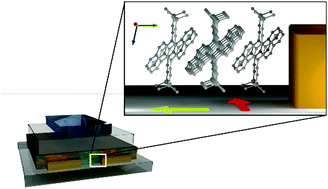Organic thin films with charge-carrier mobility exceeding that of single crystals†
Abstract
The performance of organic field-effect transistors (OFETs) depends heavily upon the intrinsic properties and microstructure of the semiconducting layer, the processes taking place at the semiconductor/dielectric interface, and the quality of contacts. In this article, we report on 7,14-bis(trimethylsilylethynyl) benzo[k]tetraphene single crystal and thin-film OFETs and compare their properties. We find that the single crystals exhibit a pronounced anisotropy in electrical characteristics, with a maximum field-effect mobility of 0.3 cm2 V−1 s−1. Through density functional theory (DFT) calculations we identified the main direction for hole transport, which was confirmed by X-ray diffraction (XRD) measurements as parallel to the plane of the single crystal facet where the transport was probed. By processing the material as a thin-film semiconductor, the content of high-mobility direction probed within the transistor channel was enhanced. The control of film morphology, coupled with a different design of the device structure allowed us to obtain an order of magnitude higher charge-carrier mobilities and a very small spread in device performance.



 Please wait while we load your content...
Please wait while we load your content...